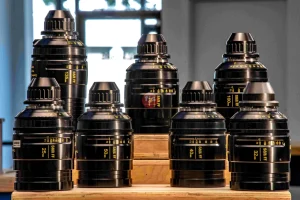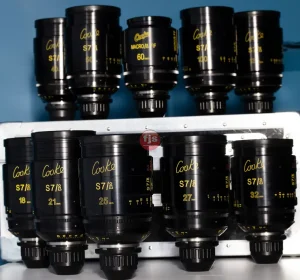One of the most frequent questions we receive at Duclos Lenses is in regards to the different versions of the Zeiss Super Speeds. Sticking to just the 35mm format (not 16mm format) version of Zeiss high speed primes, we’ll discuss some of the basic differences in an attempt to clarify some common misconceptions around the heritage of these illustrious prime lenses.
Many people are surprised to learn that the name “Super Speeds” was never actually used by Zeiss for their classic high-speed primes. This was a name that fans lovingly assigned to these lenses to distinguish them from Zeiss’s slower “Standard Speed” primes. It wasn’t until 2012 that Zeiss officially used the name “Super Speed” for a few of the faster lenses in their CP.2 line. Despite Zeiss’s lack of official monikers, nine times out of ten, when someone says “Super Speeds,” they’re referring to the classic high-speed primes from the 70s, 80s, and 90s.
now, the actual name “Super Speed” refers to the maximum aperture of the lenses. The slower line of Zeiss primes were often referred to as “Standard Speeds,” which featured a maximum aperture of T2.1. The SUPER Speeds had an impressive fast aperture of T1.4 or even T1.3. This is where things begin to get confusing for some people. The earliest line of high-speed primes were commonly referred to as “B-Speeds.” We’ll start with this line and go over their basic features and how to properly identify them.
B-Speeds
The B-Speeds were first introduced in the mid 70s as a set of prime lenses with a maximum aperture of T1.4. The set consisted of an 18mm, 25mm, 35mm, 50mm, and 85mm. The B-Speed name comes from the fact that they were originally shipped from the factory in an Arri Bayonet Mount (B-Mount).
Note that the front engraving on these classic primes will show a number that is NOT a T-stop rating, but rather an f/stop. The /f stop was the theoretical aperture of the lens, factorable, as it were whereas the T-stop markings on the iris ring were the actual measurable light being passed through the lens, onto the film. Speed aside, one of the most defining features of the B-Speeds is their triangular iris configuration.
Despite having a 9-bladed diaphragm, the lenses produce a unique, unmistakable triangle shape. Wide-open, the lenses produce beautiful round bokeh, but as soon as you stop down, the bokeh becomes triangular.
Mk I Super Speeds
Zeiss has updated its line of high-speed primes with the Mk I Super Speeds. The update to the B-speeds includes an all-new mechanical design for the entire set. The optics have remained the same for the 18mm, 25mm, and 35mm, but Zeiss has refreshed the optical design of the 50mm and 85mm.
The Mk I series of lenses was released in the mid-80s and quickly became a standard in the motion picture industry. The lenses featured a common 80mm front diameter, integrated focus gears, and a new positive lock PL mount. The focus ring gained a very useful 32-pitch gear, while the iris remained a knurled grip. After-market iris gears can be added to the Mk I primes to modernize them, but they are otherwise very reliable and durable lenses.
Mk I “Expanded Scale” Super Speeds
In the late 1980s, Zeiss refreshed the Mk I design by increasing the focus rotation from a half rotation to a nearly full rotation. These updated models were called Mk I Expanded Scale. Everything else about them, from the optics to the chassis to the front and rear housing, was identical to the earlier Mk I primes.
The main difference between the Mk I and updated Speeds is the rotation and layout of the focus ring/scale. On the earlier Mk I Speeds, an imperial scale was displayed on one side of the lens, with a metric scale on the opposite side – hence the need for only a half rotation. With the updated Expanded Scale, Zeiss was able to engrave the lenses with both metric and imperial focus marks AND a full rotation, since the distance marks were now tandem instead of in-line.
Mk II Super Speeds
In the early 1990s, Zeiss updated their line of high speed primes with an iris gear. This minor change was very welcomed by the industry and is now considered an industry standard. The optical and mechanical construction remains unchanged from the Mk I. It is also worth noting that around this time Zeiss took the opportunity to add the (rather rare) 65mm focal length to the line of Super Speeds.
The Zeiss Super Speeds MkIII are the most sought after of the Super Speeds. With the popularity and rarity of the Mk III, you would think there is some special, magical upgrade that makes them infinitely better than the Mk II. You would be wrong. Similar to the previous enhancements, the ONLY upgrade from the Mk II to Mk III is the focus scale orientation.
The focus marks on the older Mk II are in-line with the lens body, which means when you mount them to a camera, the focus marks are sideways. In response to user feedback, Zeiss updated the focus scales on the Mk III by increasing the font size and rotating the engravings 90 degrees to orient the focus marks upright when the lens is mounted to the camera. However, some users viewed this as a down-grade.
The focus marks on the lenses were made larger and more legible, which resulted in no more room for the dual-unit focus scale. This meant that the lenses came with a Metric OR Imperial scale, but not both. The final revision came about in the mid 90s and enjoyed a relatively short production run.








